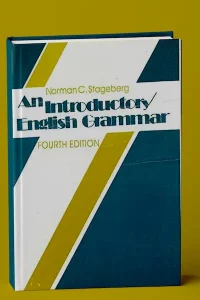An Introductory English Grammar book is intended for university-level students of English who have taken a practical grammar course and are now ready to take a course in theoretical grammar.
This book aims to provide the students with a brief survey of English morphological problems in the light of present-day linguistics.
An Introductory English Grammar
For a start, let us try and answer the question “what is grammar?” The term grammar is derived from the Greek word grammatikē, where gram meant something written. The part tikē derives from technē and meant art. Hence grammatikē is the art of writing. Since its appearance in ancient Greece the term has undergone considerable modifications. In ancient Greece and ancient Rome the terms grammatikē and Grammatica respectively denoted the whole apparatus of literary study. In the middle ages, grammar was the study of Latin. In England, this conception of grammar continued until the end of the 16th century. Latin grammar was the only grammar learned in schools. Until then there were no grammars of English. The first grammar of English, Bref Grammar for English, written by William Bullokar, was published in 1585. The most influential grammar of English (published in 1762) was R. Lowth’s Short Introduction to English Grammar. It started the age of prescriptive grammar. To a prescriptive grammarian, grammar is rules of correct usage; its aim was to prescribe what is judged to be correct rather than to describe actual usage.
A new, modern understanding of grammar appeared only by the end of the 19th century, when the period of scientific (descriptive) grammar began. To descriptivists, grammar is a systematic description of the structure of a language. With the appearance of structural descriptive linguistics, grammar came to mean the system of word structures and word arrangements of a given language at a given time. To transformational-generative grammarians, who are an offshoot of structural descriptive linguistics, grammar is a mechanism for producing sentences. Thus the actual definition of grammar is determined by pragmatic factors. If we wish to learn to speak and write, we will focus on the system of rules that underlie a given language, and if we wish to describe the structure of a language, we will focus on the units that make up the language and their relations, and if we wish to understand how speakers of a given language produce and understand sentences, we will focus on the nature of the rules used. Hence we can speak of two types of grammar: practical and theoretical. Practical grammar gives practical rules of the use of the linguistic structures while theoretical grammar gives an analysis of the structures in the light of general principles of linguistics and the existing schools and approaches.
Historically, English grammars, according to their general aims and objectives, can be divided into: a) traditional (prescriptive and non-structural descriptive): b) structural descriptive and c) transformational-generative.


